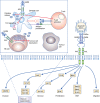Giving AXL the axe: targeting AXL in human malignancy
- PMID: 28072762
- PMCID: PMC5318970
- DOI: 10.1038/bjc.2016.428
Giving AXL the axe: targeting AXL in human malignancy
Abstract
The receptor tyrosine kinase AXL, activated by a complex interaction between its ligand growth arrest-specific protein 6 and phosphatidylserine, regulates various vital cellular processes, including proliferation, survival, motility, and immunologic response. Although not implicated as an oncogenic driver itself, AXL, a member of the TYRO3, AXL, and MERTK family of receptor tyrosine kinases, is overexpressed in several haematologic and solid malignancies, including acute myeloid leukaemia, non-small cell lung cancer, gastric and colorectal adenocarcinomas, and breast and prostate cancers. In the context of malignancy, evidence suggests that AXL overexpression drives wide-ranging processes, including epithelial to mesenchymal transition, tumour angiogenesis, resistance to chemotherapeutic and targeted agents, and decreased antitumor immune response. As a result, AXL is an attractive candidate not only as a prognostic biomarker in malignancy but also as a target for anticancer therapies. Several AXL inhibitors are currently in preclinical and clinical development. This article reviews the structure, regulation, and function of AXL; the role of AXL in the tumour microenvironment; the development of AXL as a therapeutic target; and areas of ongoing and future investigation.
Conflict of interest statement
CMG and KB report no disclosures or conflicts of interest. LAB reports personal fees from Medivation, Inc., personal fees from AstraZeneca Pharmaceuticals, personal fees from AbbVie, personal fees from BioMarin Pharmaceutical Inc., and personal fees from Astex Therapeutics outside the submitted work. She is also site principal investigator for the referenced clinical trial NCT02424617.
Figures


References
-
- Ben-Batalla I, Schultze A, Wroblewski M, Erdmann R, Heuser M, Waizenegger JS, Riecken K, Binder M, Schewe D, Sawall S, Witzke V, Cubas-Cordova M, Janning M, Wellbrock J, Fehse B, Hagel C, Krauter J, Ganser A, Lorens JB, Fiedler W, Carmeliet P, Pantel K, Bokemeyer C, Loges S (2013) Axl, a prognostic and therapeutic target in acute myeloid leukemia mediates paracrine crosstalk of leukemia cells with bone marrow stroma. Blood 122(14): 2443–2452. - PubMed
Publication types
MeSH terms
Substances
Grants and funding
LinkOut - more resources
Full Text Sources
Other Literature Sources
Research Materials
Miscellaneous

